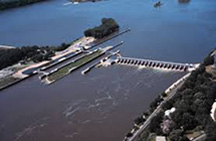 |
 |
|
| eNews • May 2014 | ||
| Promoting a Cost-Effective, Reliable and Competitive Transportation System |
||
 Soybean Farmers Explore Potential for Private Investment in Locks and Dams
Soybean Farmers Explore Potential for Private Investment in Locks and Dams
Americaâs inland waterway system, including the network of locks and dams, has been and continues to be a major contributor to the profitability and competitiveness of the U.S. soybean farmer. For U.S. agriculture, the nationâs navigable waterways are unique not because of their ability to accommodate commercial traffic, but rather due to their close proximity to the most productive farm ground in the world. While other countries have navigable waterways, they are often far removed from those regions most accountable for agricultural production. In the United States, these waterways are very accessible to a high percentage of the nationâs agricultural production, thereby allowing farmers to connect with international customers in a cost effective and reliable manner.
Despite the recognized importance of the inland waterway system to the success of the American soybean farmer, and the broader economy, the condition of the nationâs locks and dams continues to degrade due to repeated and persistent underinvestment from the federal government. As a result, a recent study funded by the soybean checkoff explores the potential for engaging and accessing private funding to enhance the condition of the inland waterway system.
âGiven the continued lack of federal resources toward our lock and dam system, more attention is being devoted to alternative sources of funding, including private equity,â says Patrick Knouff, a soybean farmer from Minster, Ohio, and chairman of the Soy Transportation Coalition. âWhile there is substantial interest in this concept, there is little understanding in how it could work. The goal of this report is to increase the awareness of both the potential advantages and shortcomings of such an approach. As we proceed toward possibly accessing private investment for our locks and dams, we need to make sure we have our eyes wide open.â
The study, âProposed Public-Private Partnership Projects for U.S. Inland Waterways Infrastructure Financing, Operations, and Governance,â was performed by The Horinko Group. The analysis provides an introduction to the concept of public-private partnerships, suggests locations that would be likely sites for such an approach, and highlights successful public-private partnerships (P3) in other industries that could serve as a model for the inland waterway system.
A P3 is a contractual agreement between a public sector agency and a private sector entity to deliver a public service. In a future P3, a non-federal entity, either one or more private entities or a public authority, could assume responsibility for the funding, operation and maintenance, replacement, and/or major rehabilitation of the locks and dams under a cooperative agreement. The Army Corps of Engineers is the agency with jurisdiction over the lock and dam system and would therefore be the federal partner in a P3 agreement. The research recommends that the U.S. government, under the jurisdiction of the Army Corps of Engineers, would retain ownership of any lock and dam site under a P3 arrangement.
The analysis suggests that under a P3 arrangement, the private sector would likely not have the appetite for investing in the construction of new lock and dam facilities. The more likely approach, according to the report, would be for private investment being devoted to proper maintenance of existing sites.
âThe Soy Transportation Coalition continues to argue that a predictably good inland waterway system is better than a hypothetically great one,â explains Mike Steenhoek, executive director of the Soy Transportation Coalition. âGiven the reality that the cost of one lock construction project ($376.8 million) is approximately equal to the cost of nine major rehabilitation projects ($40.7 million each), we concur with the recommendation that a P3 project focused on maintenance is more viable that one premised on new construction. Just because you open the door for private investment does not mean private investment will want to walk through that door. The investment opportunity must be attractive. Emphasizing maintenance of lock and dam sites over new construction will make this investment opportunity more appealing to the private sector.â
The analysis highlights two possible sites for a P3 pilot project â" Peoria and LaGrange locks and dams on the Illinois River and Locks and Dams 24, 25, 26 (Melvin Price Locks and Dam), and 27 on the Upper Mississippi River. The lock and dam sites at Peoria and LaGrange may be appealing due to their location exclusively within the state of Illinois, which could result in a more streamlined and efficient administrative process. The four lock and dam sites on the Upper Mississippi River may be appealing due to their high volume of barge traffic along with comparatively lower maintenance costs required in the immediate future.
It is widely accepted and anticipated that the final version of the Water Resources Development Act will authorize the establishment of a series of pilot projects to examine the feasibility of a P3 approach to the inland waterways system. Congressional negotiators are currently finalizing the legislation. It is expected to be considered and passed by both the House of Representatives and the Senate and signed by the President in May or June.
âIn our estimation, a public-private partnership approach for locks and dams could be appealing because of the potential for better project execution and delivery,â says Steenhoek. âThe private sector often is better able and equipped to deliver the same or elevated services at a lower cost. We believe it is appropriate to examine and investigate alternative methods to finance, operate, maintain, and enhance our inland waterway system. We hope this analysis and soybean farmers in general can play a constructive role in this important discussion.â
The full results of the study can be accessed at www.soytransportation.org or www.unitedsoybean.org.
Soy Transportation Coalition |
|
